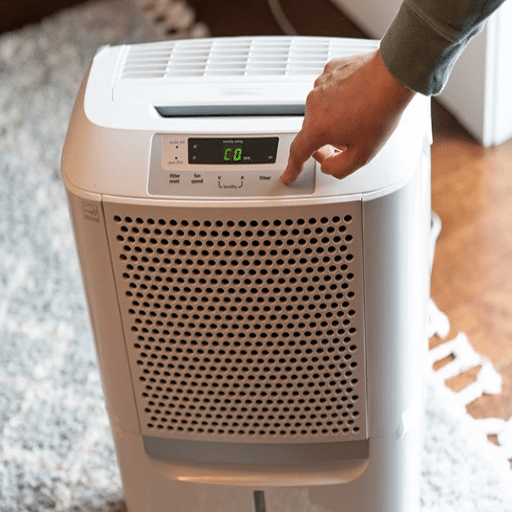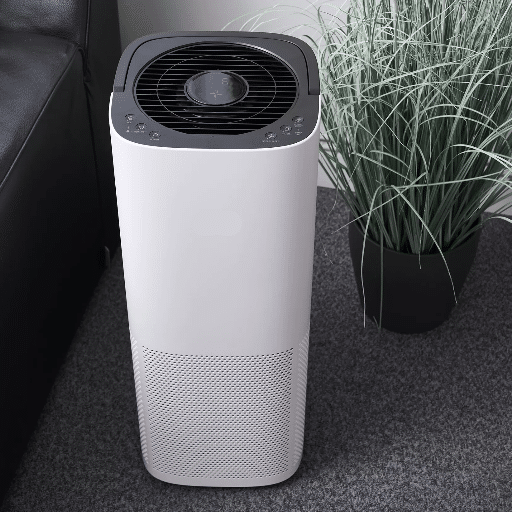When it comes to managing indoor comfort, both dehumidifiers and air conditioners play distinct yet complementary roles. Yet, for many homeowners, a common question arises—how do these devices differ in energy consumption and efficiency? Understanding their unique functions is crucial, especially when energy costs and environmental concerns are top of mind. This article dives into the essential differences between dehumidifiers and air conditioners, breaking down how each device operates, the impact they have on energy usage, and which one might be the better fit for your needs. Whether you’re aiming to maximize cost savings, improve air quality, or create a more sustainable living space, this guide will equip you with the knowledge to make an informed decision tailored to your home and lifestyle.
How Does a Dehumidifier Work?
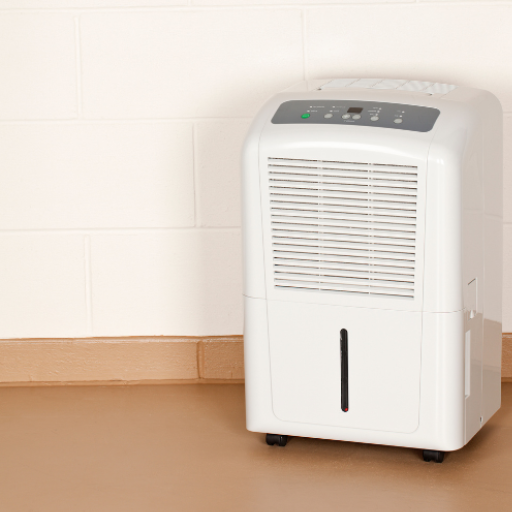
A dehumidifier works by removing excess moisture from the air to reduce humidity levels in a space. It draws in damp air using a fan, passes it over cold coils to condense the moisture into water, and then collects the water in a tank or drains it away. The now drier air is reheated slightly and released back into the room. This process helps prevent issues like mold growth, dust mites, and a muggy atmosphere, improving comfort and air quality in your home.
What is the role of a dehumidifier in humidity control?
A dehumidifier plays a crucial role in maintaining the optimal humidity levels in a living or working space, generally recommended to be between 30% and 50% relative humidity. When humidity exceeds this range, it creates an environment conducive to mold and mildew, which can trigger allergies and respiratory issues. Excess humidity can also damage furniture, walls, and floors, especially in areas like basements, bathrooms, or poorly ventilated spaces.
Modern dehumidifiers are equipped with advanced features to efficiently manage humidity. For instance, many devices now include built-in hygrometers to monitor humidity levels in real-time, allowing automatic control to maintain an ideal balance. Some models even improve energy efficiency, using compressors or desiccant technologies to reduce energy consumption while still effectively extracting moisture. Recent reports indicate that high-performance residential dehumidifiers can remove between 20 to 50 pints of water daily, depending on their capacity and the environmental conditions.
The impact of maintaining healthy humidity levels extends beyond comfort—it can lead to long-term cost savings. For example, by reducing humidity, the workload on air conditioning systems can be decreased, which helps cut overall energy bills. Additionally, managing moisture prevents structural damage to your home, reducing repair costs over time. Using a dehumidifier is not just about comfort, but also about protecting your health, home, and investment.
How does a dehumidifier remove moisture from the air?
A dehumidifier works by drawing in humid air, extracting moisture, and releasing dryer air back into the environment. This process typically involves several key components and phases:
- Air Intake and Cooling Process
The dehumidifier uses a fan to pull in air from the surrounding space. Once inside, the air passes over a set of refrigerated coils. These coils, cooled to temperatures below the dew point, cause the moisture in the air to condense into liquid form, effectively removing water vapor.
- Condensation and Collection
The condensed moisture drips into a collection tank or is directed through a drainage hose to an external location. Modern dehumidifiers often include features such as water-level indicators or automatic shut-off systems when the tank is full, ensuring hassle-free operation.
- Releasing Dry Air
After moisture is removed, the air is reheated via a warm coil and released back into the room. This ensures consistent air temperature while maintaining reduced humidity levels.
- Efficiency and Impact
Advanced models utilize energy-efficient compressors and smart humidity sensors, allowing precise control over indoor air conditions. For example, studies suggest that keeping indoor relative humidity levels between 30-50% not only improves comfort but also helps mitigate the growth of mold, mildew, and dust mites—common triggers for allergies and respiratory issues.
By employing this cycle repeatedly, a dehumidifier significantly reduces dampness, preventing potential damage to furniture, walls, and electronics while ensuring a healthier living environment.
What is the impact of a dehumidifier on indoor air quality?
A dehumidifier plays a pivotal role in improving indoor air quality by regulating moisture levels. High humidity can foster the proliferation of mold, mildew, and dust mites, all of which are significant contributors to poor air quality and can exacerbate respiratory issues like asthma or allergies. Research indicates that maintaining relative humidity levels between 30% and 50% not only enhances comfort but also significantly reduces allergen presence in the air.
By extracting excess moisture, dehumidifiers prevent damp conditions that can lead to musty odors and the spread of airborne pollutants. Additionally, managing indoor humidity helps protect materials like drywall and upholstery, which can otherwise act as breeding grounds for volatile organic compounds (VOCs) if exposed to prolonged dampness. A study published in the Journal of Environmental Health and Engineering highlights that environments with controlled humidity see as much as a 45% decrease in microbial activity, contributing to fresher, cleaner indoor air.
Modern dehumidifiers often come equipped with advanced features like HEPA filtration or UV light systems. These additional technologies further enhance air purification by capturing fine particulates and neutralizing bacteria or viruses. This makes dehumidifiers a valuable tool in creating a healthier, more comfortable home environment, particularly in areas prone to high humidity or seasonal dampness.
Understanding Air Conditioner Operations
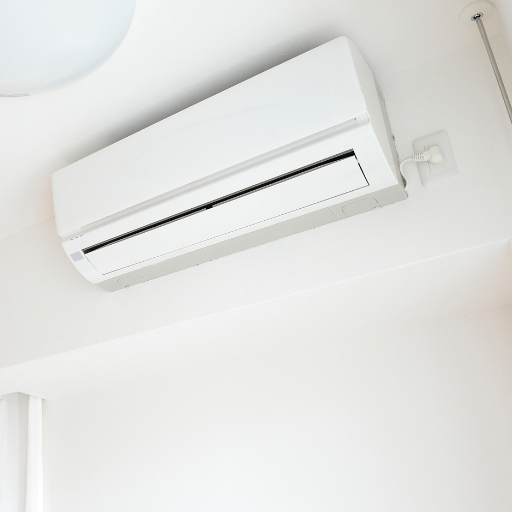
Air conditioners work by regulating indoor air temperature, humidity, and circulation to create a comfortable environment. They operate using a simple cycle of cooling, which involves drawing in warm air, passing it over refrigerated coils to remove heat, and then releasing the cooled air back into the room. Excess heat is expelled outside through an external unit. Modern air conditioners also help filter the air, capturing dust and other particles, contributing to improved indoor air quality. The system is straightforward and highly effective for maintaining comfort, especially in hot or humid conditions.
How do air conditioners work to cool the air?
Air conditioners function using the principles of thermodynamics and the refrigeration cycle. At the center of this operation is the refrigerant—a unique chemical compound capable of transitioning between liquid and gaseous states. During the cooling process, the refrigerant absorbs heat from the indoor air as it passes through the evaporator coils, lowering the temperature of the air circulated back into the room.
Once the refrigerant absorbs the heat, it transitions into a gaseous state and moves to the compressor, where it is pressurized. This pressurization significantly increases its temperature. The heated refrigerant then flows to the condenser coils located in the external unit, where it releases the absorbed heat into the outdoor environment. Finally, the refrigerant cools and returns to its liquid state, ready to repeat the cycle.
Modern air conditioning systems are engineered for high energy efficiency, with many equipped with variable-speed compressors and smart thermostats. These advancements can reduce energy consumption by up to 30% compared to conventional models, according to energy efficiency studies. Additionally, many systems come with enhanced air filtration capabilities, which can capture up to 99% of pollutants and allergens, further improving indoor comfort and health.
By combining cutting-edge technology with precise mechanisms, air conditioners effectively create a comfortable indoor environment, ensuring both temperature control and improved air quality. This makes them indispensable in homes, offices, and industrial settings, particularly in regions where temperatures frequently exceed 85°F (29°C).
What is the difference between an air conditioning unit and a dehumidifier?
Air conditioners primarily cool air and vent heat outdoors, while dehumidifiers focus on removing moisture and release heat indoors.
| Parameter | Air Conditioner | Dehumidifier |
|---|---|---|
|
Function |
Cooling |
Dehumidifying |
|
Heat Output |
Outdoors |
Indoors |
|
Humidity |
Limited Control |
Precise Control |
|
Temp Effect |
Lowers |
Slightly Raises |
|
Sensor |
Thermometer |
Hygrometer |
|
Best Use |
Hot Weather |
High Humidity |
How does an air conditioning system manage humidity?
Air conditioning systems manage humidity by cooling the air and simultaneously removing excess moisture through a process called condensation. When warm, humid air passes over the evaporator coil, the coil’s cold surface causes the moisture in the air to condense into water droplets. This water is collected in a drip pan and drained away, leaving the air drier and more comfortable.
Modern air conditioners are designed to balance cooling and dehumidification efficiently. Many systems incorporate advanced features such as variable-speed compressors, which adjust the cooling capacity to match indoor needs and maintain optimal humidity levels, typically between 30–50%. These systems ensure energy efficiency while offering precise moisture control. Additionally, some cutting-edge units utilize sensors that monitor indoor humidity and adjust airflow and cooling accordingly.
Data from recent studies suggest that effective humidity management enhances indoor air quality, reduces allergens such as mold and dust mites, and increases overall comfort. For areas with higher humidity, specialized air conditioning models with enhanced dehumidification capabilities ensure consistent indoor climate control, even under challenging weather conditions.
Comparing Energy Consumption: Dehumidifier vs Air Conditioner
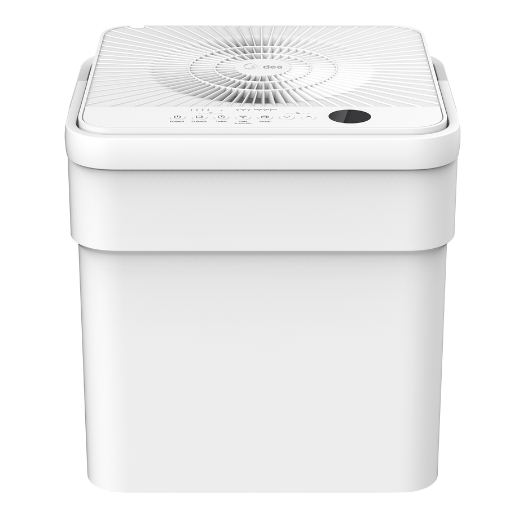
When comparing energy consumption, dehumidifiers generally use less energy than air conditioners. A dehumidifier focuses only on removing excess moisture from the air, making it more energy-efficient for humidity control. On the other hand, an air conditioner cools the air while also dehumidifying it, which typically requires more energy to power its cooling components. For managing humidity in moderate conditions, a dehumidifier is often the better choice for energy savings. However, if cooling and humidity control are both needed, an air conditioner may be more practical despite its higher energy use.
Which uses less energy: a dehumidifier or an air conditioning unit?
To determine which device uses less energy, it’s essential to compare their typical energy consumption based on practical usage scenarios and efficiency ratings. A standard dehumidifier typically consumes between 300 to 700 watts per hour, depending on its size and capacity. On the other hand, air conditioning units, especially window or central air systems, usually require significantly more energy, averaging between 1,000 to 2,500 watts per hour, depending on their cooling capacity and system efficiency.
The disparity in energy use becomes more pronounced when considering that air conditioners perform dual functions—they cool the air and remove moisture. This additional cooling feature necessitates higher energy output. Conversely, dehumidifiers focus solely on removing moisture, making them more energy-efficient in situations where cooling the air isn’t required.
For example, a humid room in moderate conditions might benefit from using a dehumidifier alone, consuming approximately 4.8 kWh of energy per day if running for 8 hours at 600 watts. An air conditioner operating under similar conditions could use nearly 16 kWh per day with an average consumption of 2,000 watts. Therefore, for purely humidity control, a dehumidifier is more energy-efficient.
However, it’s worth noting that advanced air conditioning units with higher SEER (Seasonal Energy Efficiency Ratio) ratings and inverter technology are designed to use energy more efficiently. These units can reduce overall energy consumption compared to older models, making them a more acceptable option if both cooling and dehumidifying are necessary.
The choice between a dehumidifier and an air conditioner should depend on your specific needs—if you only need to manage moisture levels, a dehumidifier will almost always consume less energy. Still, for combined cooling and dehumidification, evaluating energy ratings and features of air conditioners becomes crucial for cost-effective operation.
How is energy efficiency measured in dehumidifiers and air conditioners?
Energy efficiency in dehumidifiers and air conditioners is typically measured using specific industry-standard metrics. For dehumidifiers, the term Integrated Energy Factor (IEF) is commonly used. The IEF measures how many liters of water a dehumidifier removes per kilowatt-hour (kWh) of energy consumed. The higher the IEF, the more energy-efficient the dehumidifier. For example, Energy Star-certified dehumidifiers must meet strict IEF requirements, which can vary by size and capacity. Choosing a unit with a higher IEF not only reduces energy costs but also contributes to environmental conservation by minimizing energy waste.
For air conditioners, energy efficiency is primarily assessed through the Seasonal Energy Efficiency Ratio (SEER) and Energy Efficiency Ratio (EER). SEER measures the cooling efficiency over an entire cooling season under varied temperatures, while EER evaluates efficiency at a specific outdoor temperature (usually 95°F). Modern energy-efficient air conditioners typically have SEER ratings of 14 or higher, with some high-performance units reaching SEER ratings of 20 or more. Additionally, the Energy Star label on air conditioners ensures they meet stringent EPA requirements for reduced energy usage and operating costs.
Considering these metrics while shopping for a dehumidifier or air conditioner allows users to make informed decisions that balance performance with energy savings. Both IEF and SEER/EER ratings provide critical insights into operational costs and environmental impact, helping consumers achieve long-term efficiency and sustainability.
What are the energy savings benefits of using a dehumidifier?
Dehumidifiers play a pivotal role in reducing energy consumption by enhancing the efficiency of climate control systems, particularly air conditioners. By extracting excess moisture from the air, dehumidifiers alleviate the burden on air conditioning units, which would otherwise work harder to cool humid environments. For instance, maintaining a relative humidity level between 30% and 50% not only creates a more comfortable indoor atmosphere but also enables lower thermostat settings, effectively cutting down on energy use. Studies indicate that air conditioners can consume up to 30% more energy when operating in highly humid conditions, underscoring the importance of pairing them with an efficient dehumidifier.
Additionally, modern dehumidifiers equipped with Energy Star certification are designed to use up to 15% less energy than conventional models, saving households an estimated $175 annually on electricity bills. These devices often feature advanced settings such as adjustable humidity controls and auto-shutoff functions, ensuring optimized performance and minimal energy waste. Over time, the combined benefits of reduced strain on HVAC systems and efficient standalone operation contribute significantly to both lower utility bills and a reduced environmental footprint.
The Role of Humidity Level in Energy Consumption
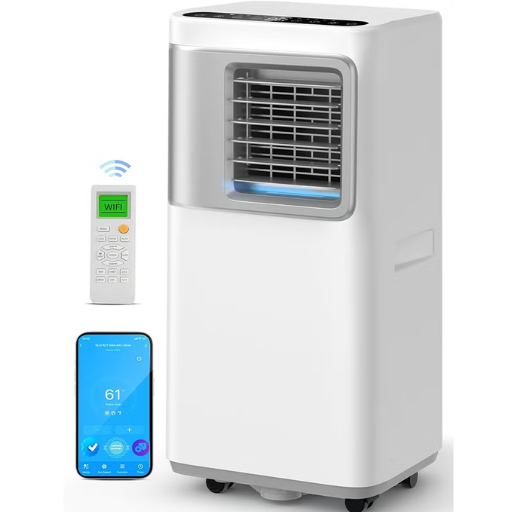
Humidity levels play a critical role in determining energy consumption within a home. High humidity makes the air feel warmer, prompting increased use of air conditioning systems to maintain comfort. Conversely, overly dry air during colder months can lead to higher heating usage as occupants attempt to offset discomfort. By maintaining optimal humidity levels—typically between 30% and 50%—households can reduce the dependency on heating and cooling systems, leading to lower energy use and cost savings. Proper humidity management also enhances indoor air quality and reduces wear on HVAC systems, ensuring long-term efficiency.
How does high humidity affect the performance of an air conditioner?
High humidity significantly impacts the efficiency and performance of an air conditioner, as it increases the workload of the system. When the air is saturated with moisture, the cooling process requires more energy since the air conditioner must not only cool the air but also dehumidify it. This dual function places additional strain on the compressor and other components, potentially causing the unit to run longer cycles and consume more electricity.
For instance, studies show that an air conditioner operating in high humidity environments can experience a reduction in efficiency by up to 30% compared to optimal conditions. Furthermore, elevated humidity levels can contribute to uneven cooling, making rooms feel warmer than the thermostat setting while also increasing the risk of mold growth and deterioration of ductwork due to condensation. To combat these challenges, many modern HVAC systems are designed with built-in or compatible dehumidification features, which can help regulate indoor moisture levels and maintain overall system performance.
Additionally, consistent maintenance, including cleaning or replacing air filters and ensuring proper airflow, is crucial to ensure the air conditioner can effectively handle the burdens posed by excessive humidity without a significant drop in performance or longevity. Keeping humidity levels at the recommended 30%-50% range not only alleviates stress on the system but enhances comfort and reduces energy costs in the process.
Can a dehumidifier help reduce humidity and energy use?
A dehumidifier plays a vital role in reducing indoor humidity levels, creating a more comfortable and healthier living environment. By extracting excessive moisture from the air, it helps prevent issues like mold growth, dust mites, and a musty odor, all of which thrive under high humidity conditions. Not only does this improve air quality, but it can also make spaces feel cooler, reducing the reliance on air conditioning systems.
From an energy efficiency perspective, a dehumidifier can complement your air conditioning unit by alleviating the burden on the system. When humidity levels are high, air conditioners often need to work harder to cool and dehumidify the air, leading to increased energy consumption. By maintaining indoor humidity in the optimal range (30-50%), a dehumidifier can help your air conditioner operate more efficiently, potentially lowering energy usage by up to 10-15%, according to studies focused on indoor climate control.
For a practical perspective, modern energy-efficient dehumidifiers use relatively low wattage—typically ranging between 300 and 700 watts, depending on the model and capacity. By removing moisture from the air, these devices can create a more pleasant temperature balance, allowing thermostats to be set at higher levels without compromising comfort. Over time, this can contribute to noticeable energy savings, especially during humid months.
Investing in a properly sized, energy-efficient dehumidifier tailored to your space ensures that you optimize both its functionality and energy-saving potential. Pairing this with proper home insulation, such as sealing windows and doors, amplifies its effectiveness, offering a dynamic solution to combating excess humidity and unnecessary energy expense.
What is the ideal humidity level for energy-efficient indoor environments?
Maintaining the ideal indoor humidity level is crucial for both comfort and energy efficiency. Personally, I aim to keep the humidity level in my home between 30% and 50%, as this range prevents excessive moisture, reduces strain on cooling and heating systems, and minimizes the growth of mold and allergens. Staying within this range ensures a healthier and more energy-efficient living environment.
Choosing Between an Air Conditioner and a Dehumidifier
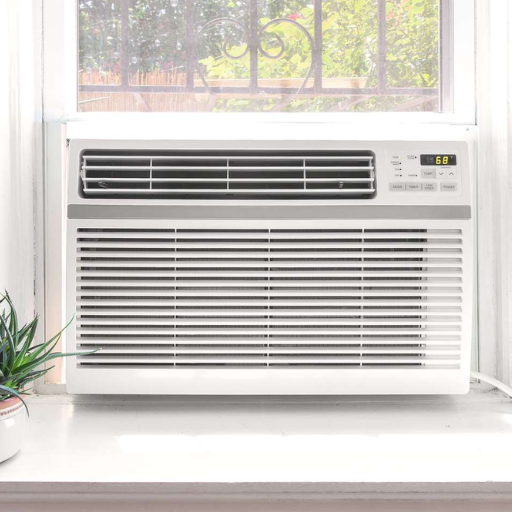
When deciding between an air conditioner and a dehumidifier, it’s important to understand their primary functions. An air conditioner cools the air and also removes excess moisture as a secondary benefit, making it ideal for hot and humid conditions. A dehumidifier, on the other hand, solely focuses on reducing humidity, which is beneficial in spaces that feel damp or musty but don’t necessarily need cooling.
If your main concern is high humidity without high temperatures, a dehumidifier is likely the better choice. However, if you need a solution for both heat and humidity, an air conditioner can address both issues effectively. Consider the specific conditions of your space to select the option that best meets your comfort and health needs.
What factors should be considered when choosing an air conditioner or dehumidifier?
- Room Size and Coverage
The size of the room where the device will be used is a critical factor. Air conditioners and dehumidifiers come with specific coverage area ratings, usually measured in square feet. For example, a 5,000 BTU air conditioner can cool a room up to 150 square feet, while a portable dehumidifier might handle spaces ranging from 250 to 4,500 square feet depending on its capacity.
- Climate and Seasonal Needs
Consider the climate of your location and the time of year you plan to use the device. Air conditioners are particularly effective in hot and humid climates, as they cool and dehumidify the air simultaneously. On the other hand, dehumidifiers are optimal for year-round humidity control, especially in damp or mold-prone environments.
- Moisture Levels
Measure the relative humidity (RH) in the room. For spaces with RH levels exceeding 60%, a dehumidifier is essential to maintain a comfortable and safe environment. Air conditioners reduce humidity to some extent, but they are less precise in managing RH levels compared to a dedicated dehumidifier.
- Energy Efficiency
Look for the Energy Efficiency Ratio (EER) or Seasonal Energy Efficiency Ratio (SEER) for air conditioners and check for Energy Star certifications on both devices. Air conditioners typically consume more electricity than dehumidifiers due to their dual cooling and dehumidifying functions, so weigh ongoing energy costs carefully.
- Noise Levels
For areas like bedrooms or offices, noise levels can be a deciding factor. Dehumidifiers often operate more quietly than air conditioners, with sound output ranging from 35 to 60 decibels, compared to 40 to 70 decibels for many air conditioners.
- Portability and Installation Requirements
Air conditioners, especially window or wall-mounted units, require installation and may be less portable. Conversely, many dehumidifiers are designed to be lightweight and portable, often featuring wheels or handles for easy movement between rooms.
- Features and Functionality
Modern air conditioners and dehumidifiers offer various features, such as automatic humidity sensors, remote controls, programmable timers, and energy-saving modes. Some high-end models may even integrate with smart home systems for added convenience.
- Cost and Budget
Initial costs vary significantly depending on the type, size, and brand of the unit. Air conditioners generally involve higher upfront and maintenance costs, while dehumidifiers are more budget-friendly in both initial and operating expenses.
- Maintenance and Lifespan
Both devices require regular maintenance to function effectively. Air conditioners need periodic filter cleaning, refrigerant level checks, and annual servicing. Dehumidifiers require frequent tank emptying or drainage hose setup and filter cleaning. Factor in these maintenance tasks when choosing between the two.
- Health Considerations
If you or a family member suffers from allergies, asthma, or respiratory conditions, a dehumidifier can significantly improve indoor air quality by reducing mold and dust mites. Air conditioners, while helpful in cooling, may distribute allergens if filters aren’t cleaned regularly.
By accounting for these factors, you can make an informed decision tailored to your specific indoor environment and comfort needs.
How can you determine the energy usage of each appliance?
To determine the energy usage of each appliance, I would start by checking the EnergyGuide label or the manufacturer’s specifications, which usually indicate the wattage or estimated energy consumption. Additionally, I could use an energy usage monitor to directly measure how much electricity the appliance consumes while in operation. This approach allows me to make accurate comparisons and assess the long-term costs associated with each device.
When is it best to use a dehumidifier over an air conditioner?
A dehumidifier is best used over an air conditioner when the primary concern is reducing excess moisture in the air rather than cooling the environment. Dehumidifiers are designed to extract moisture, creating a more comfortable and healthier indoor environment, especially in regions or seasons with high humidity levels. According to recent data, ideal indoor humidity levels should range between 30% and 50% to prevent issues such as mold growth, dust mites, and a damp feeling in the room.
For example, in basements or poorly ventilated spaces, where excess humidity often accumulates, dehumidifiers are more effective and energy-efficient than air conditioners. A medium-capacity dehumidifier can remove up to 30-40 pints of moisture per day and typically consumes around 300 watts. Comparatively, even a small air conditioner uses approximately 500-900 watts, primarily because it is designed to cool rather than focus on moisture control. Using a dehumidifier in these scenarios allows you to tackle humidity without significantly increasing energy bills.
Reference Sources
-
Optimizing energy efficiency and improved dehumidification performance of variable capacity air conditioning systems – A study on energy efficiency and dehumidification performance.
-
Improving the energy efficiency of dehumidification technology at a large facility in Florida – Focuses on energy consumption in HVAC systems.
-
Further Investigation Of Energy And Performance Impacts Of Whole-House Dehumidifier Duct Configurations – Examines energy and performance impacts of dehumidifiers.
-
Coupling Active Heat Exchange and Vacuum Membrane-Based Air Dehumidification for High-Efficiency Air Conditioning – Discusses advanced dehumidification and air conditioning technologies.
Frequently Asked Questions (FAQs)
Q: What is the primary difference between an air conditioner and a dehumidifier in terms of function?
A: An air conditioner primarily cools your home by removing heat energy and humidity from the air, while a dehumidifier focuses on reducing humidity in the air without significantly altering the indoor temperature.
Q: How does the power consumption of an air conditioner compare to a dehumidifier?
A: Generally, air conditioners have higher power consumption compared to dehumidifiers as they need to cool the air and manage both temperature and humidity. Dehumidifiers are generally more energy efficient when the goal is solely to reduce humidity.
Q: Can using an air conditioner for dehumidification lead to higher energy costs?
A: Yes, running an air conditioner solely for dehumidification can lead to higher energy costs because it uses a lot of electricity to cool the air along with removing moisture.
Q: Is it more energy efficient to run a dehumidifier in humid conditions?
A: Yes, running a dehumidifier is more energy efficient in humid conditions if the primary goal is to remove humidity from the air, as it uses less electricity compared to an air conditioner.
Q: How does the size of your home affect the choice between an air conditioner and a dehumidifier?
A: The size of your home affects the efficiency and effectiveness of both units. Larger spaces may require a more powerful air conditioner or dehumidifier to effectively manage indoor temperature and humidity levels.
Q: What role does the condensation process play in both air conditioners and dehumidifiers?
A: In both devices, the condensation process involves moist air passing over cold coils, causing the humidity in the air to condense into water. However, air conditioners also remove heat energy, while dehumidifiers focus on moisture removal.
Q: What are the benefits of using a portable air conditioner vs a dehumidifier?
A: A portable air conditioner can cool your home and dehumidify the air, making it versatile for temperature and humidity control. A dehumidifier is more energy efficient for reducing humidity without significantly changing the indoor temperature.
Q: How does running an air conditioner impact indoor temperature compared to a dehumidifier?
A: Running an air conditioner lowers the indoor temperature by removing heat energy, while a dehumidifier primarily focuses on reducing humidity levels without a significant drop in temperature.
Q: Can dehumidifiers help save energy in air-conditioned homes?
A: Yes, dehumidifiers can help save energy by reducing the humidity load on air conditioners, allowing them to cool more efficiently and potentially reducing the overall electricity consumption.
Q: What are the costs associated with running a dehumidifier vs an air conditioner?
A: The cost of running a dehumidifier is generally lower than running an air conditioner due to lower electricity consumption, especially if the primary goal is to manage humidity rather than both temperature and humidity.

